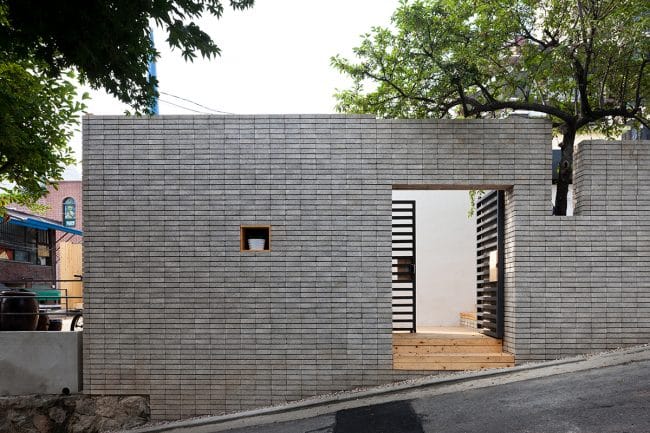한국의 오래된 주택가에서 1층의 단독주택을 찾는 것은 어려운 일이 되었다. 이 집이 지어진 42년전만 하더라도 대부분은 1층의 주택이었지만 지금은 4층 정도의 다가구주택이나 다세대주택이라고 부르는 공동주택들이 대부분을 차지하게 되었다. 임대수익을 높이기 위해 단독주택을 부수고 규모를 늘려 신축을 했기 때문이다. 그러다보니 아직까지 남아있는 단독주택들은 주변의 높은 건물들로부터 포위된 경우가 많다. 이 문제를 해결하기 위해 주변의 집들처럼 신축을 할 수도 있을 것이다. 그러나 이번에는 주변의 집들에 의해 방해를 받을 것이다. 조망권과 일조권이 제한된다는 것과 마을의 동네가 답답해진다는 이유에서 행정관청에 민원을 넣기 때문이다. 그러므로 이런 오래된 주택가에서 늦게 집을 짓는 것은 이미 집은 지은 사람들에 비해 불리할 때가 많다. 이집이 바로 그렇다.
그렇다고 해서 오래된 주택을 집수리하는 것이이 42년 정도를 버티지 못한다면 이해하기 어렵다고 할지도 모르지만 이 집이 지어질 당시의 경제적 상황과 인구의 도시의 집중화로 인해 한꺼번에 대규모로 신축이 발생하는 시대적 배경을 살펴보면 이해하지 못할 것도 아니다. 그러다보니 시멘트나 모래보다 보다 현장에서 채취한 흙의 비중이 더 높은 벽돌들이 생산되는 일이 자주 있었다. 그런 재료를 사용하여 지어진 집이 42년을 버틴 것은 오히려 놀라웠다. 그러니 단열과 방수의 상태는 오죽하겠는가? 이집이 바로 그렇다.
한국에서 부모와 아들 부부 그리고 그들의 자녀들이 함께 사는 모습은 이 집이 지어질 42년 전만 하더라도 흔한 일이었다. 그러나 지금은 그렇지 않다. 함께 살고 싶다고 할지라도 그것을 방해하는 요인 중의 하나가 현재 한국주거의 절반이상을 차지하고 있는 아파트먼트의 공간구조가 이런 경우를 염두에 두고 만들어지지 않았기 때문이다. 이런 여러 이유에도 불구하고 3세대가 한 집에서 함께 살거나 살 수밖에 없는 사정이 있다면 그때는 어떻게 해야 할까? 독서보다는 컴퓨터 게임을 사랑하는 중학교 3학년 손녀와 오줌도 가리지 못하고 집을 안팎을 사정없이 휘저어 놓는 그녀의 남동생 그리고 자신의 현재처럼 머리숱이 현저히 줄어든 중년의 아들과 그의 와이프와, 멀쩡한 화장실을 옆에 두고도 요강을 더 애호하고, 빈터만 있으면 고추, 오이, 상추를 심고 그리고 닭을 키우는 것을 좋아하는 부모가 오랫동안 서로 다른 곳에서 살다가 42년 된 단독주택을 수리하여 함께 살아야 한다면 말이다. 이집이 바로 그렇다.
From the old Korean residential zone, it is difficult to find one-story house. But even 42 years ago since this building has been built, there were a lot of one-story house. However, four-story apartment houses, which are also called as ‘multiplex housing’ or ‘multiple dwelling’ occupy most of residential zone. This is because people removed old houses and extended dimensions and then built new houses to make more profits from rent. Therefore the old houses are often surrounded by higher buildings. To solve this problem, new buildings could be constructed instead of old houses. However, then they will be disturbed by higher buildings around them. As a result of this, villagers will file a civil complaint to administrative office with the reasons of the prospect right and right sunshine are limited and village becomes stuffy. Therefore building new houses in the old residential zone in these days is more disadvantageous than people who have already built before. This house was that case.
However, Jip-Soori(Korean term for revitalization of house) of old houses is never easy. The first reason for this is because of the word ‘being old’. If a house does not stand for up to 42 years, it would be difficult for people to understand. But when think of the time when a lot of new buildings had been built in a short period of time because of the society-economic situation and population concentration phenomenon, it is understandable then.
At that period, it happened more often that the more soils from the ground were used when make bricks rather than using cements or sands. As a result of this, the bricks which were used when built the houses in the past, were not strong enough. However, it was absolutely amazing that this house (That kind of bricks written above, were used ) had not crumbled for 42 years.
But this house was this case
Before this house had been built, 42 years ago, living parents, husband and wife and their children together was normal life in Korea. But now it is not. Even though they wish to live all together like before, there is one thing that disturbs their wish. This is because of the structure of apartments located in Korea. Then I want to ask what if 3 generations have to live in the same house or they want to? For example if granddaughter, year in 9 who likes playing computer more than reading books and her little brother who always plays and runs around house, and grandfather who prefers ‘Yeo-gang’ more than modern toilet and loves gardening and poultry farming, have to renovate the ’42 years old house’ and live there all together after living separately for a long time. But this house was that case.
http://www.archdaily.com/418112/jaehoon-s-jip-soori-moohoi-architecture-studio/
http://architizer.com/projects/jaehoons-jip-soori/

